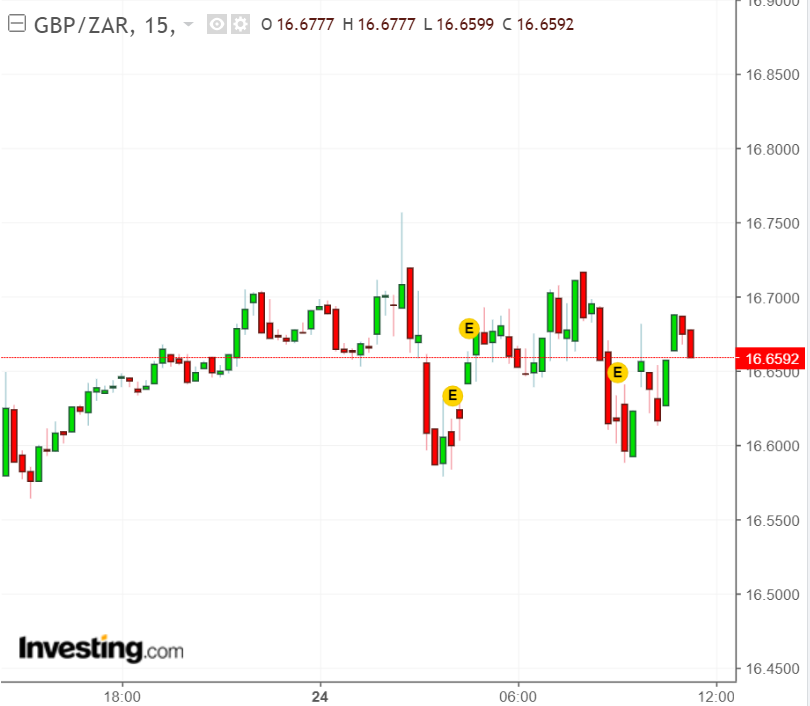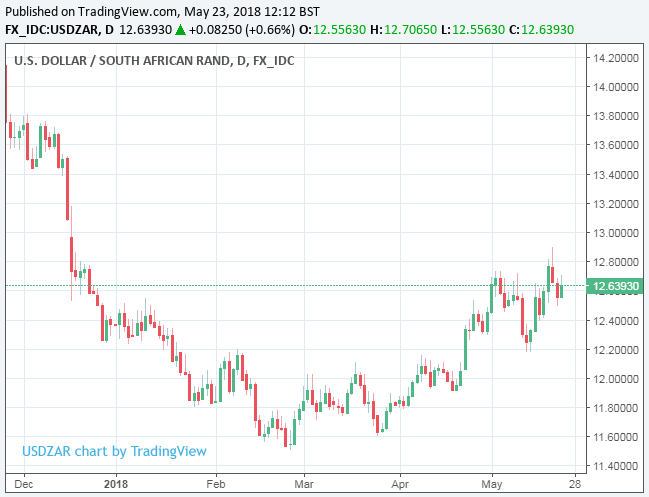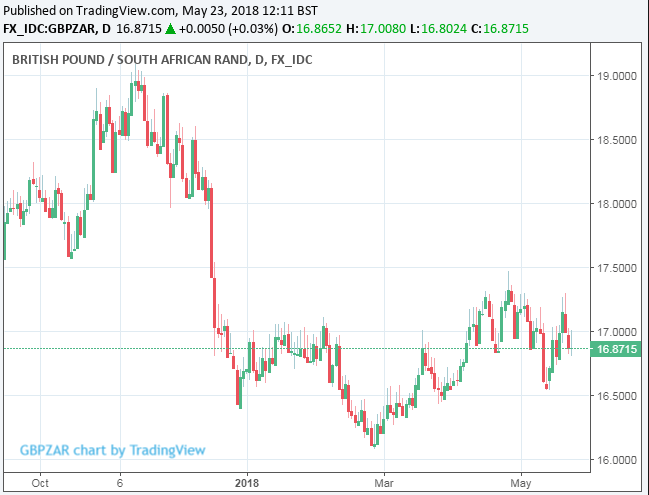Outlook For Rand Improves As SARB Contemplates Rate Hike in Q4
- Written by: James Skinner
- South African Reserve Bank (SARB) leaves rates unchnaged but raises inflation forecast.
- Sees potential rate hike of 0.25% in final quarter of 2018.
- New outlook in line with analysts' expectations. Growth upgraded in 2019

Johannesburg, South Africa, Image © Adobe Stock
The South African Reserve Bank (SARB) kept interest rates unchanged at 6.5% at their May meeting, according to an official statement from Lesetja Kganyago, governor of the SARB, delivered on Thursday afternoon.
The decision not to change the base lending rate was in line with analysts' expectations and the Rand was little changed after the news, continuing to trade between a narrow range of 16.60 and 16.70 to the Pound.
Although keeping the status quo on rates, the SARB did change its outlook on inflation which it saw as more likely to rise than fall.
"In contrast with the previous meeting, the MPC assesses the risks to the inflation forecast to have moved to the upside," says Kganyago.
"This change is mainly due to global developments," he adds.

Despite seeing inflation risks tilted to the upside the SARB did not actually change its official inflation forecasts for 2018 and 2019, which it kept at 4.9% and 5.2% respectively. It did, however, marginally upgrade the forecast for 2020 to 5.2% compared with 5.1% previously.
Inflation is expected to hit a peak of 5.5% in the first quarter of 2019 as previously forecast, "before the impact of the VAT increase largely dissipates," adds the governor.
Core inflation is forecast to fall marginally to 4.5% in 2018 but rises to 5.1% in both 2019 and 2020, from 4.9% previously. A peak of 5.2% is expected in the first quarter of 2019.
The SARB is now more likely to raise rates in the future with the implied path of policy rates generated by the SARB’s Quarterly Projection Model reflecting one 0.25% increase in interest rates during the final quarter of this year.
A similar increase is then expected in mid-2019. Two further increases are indicated in 2020.
"The generated path remains a broad policy guide, and the extent to which the MPC follows it will be determined by, among other things, the MPC’s assessment of the balance of risks to the forecast," the statement added.
The governor noted how, "the global economic backdrop has become more challenging amid continuing trade policy tensions between the US and China as well as other geopolitical risks," in his statement.
The Rand has weakened quite substantially since the last meeting due to a strengthening Dollar to which it is negatively correlated. and because of outflows due to rising US yields.
The SARB's previous forecast for GDP growth was left unchanged at 1.7% in 2018 but revised up to 1.7% from 1.5% in 2019.
"The growth outlook is underpinned by strong recoveries in both business and consumer confidence," says Lesetja Kganyago.
The SARB's assessment falls in line with what analysts at Commerzbank have been saying, who believe the SARB is now likely to raise interest rates rather than the rate cuts - as markets had expected in recent months.
The change in stance represents something of a U-turn given it was not tweo months ago that the SARB actually cut its main interest rate from 6.75% to 6.5%, citing reduced risks to its inflation target and a finely balanced outlook for economic growth in the wake of February's regime change in South African politics.
The rule of thumb in currency markets is that rising interest rates tend to support a currency, and vice versa.
The driver for any interest rate rise would likely be expectations for higher inflation; South African inflation rose by 0.8% during April, according to Statistics South Africa data released Wednesday, which is up from 0.4% in March and broadly in line with the market consensus.
That took the annual rate of inflation up to 4.5%, which is slightly less than the 4.7% rate markets had expected but enough to more than reverse an earlier fall that had pushed the consumer price index down to 3.8% in March.
This has taken consumer price inflation back toward the top end of the South African Reserve Bank target which, to keep inflation within the 3% to 6% range, would typically be enough to prompt markets to begin speculating that a rate rise might be in the cards.
Rising interest rates tends to cool inflation by restricting the amount of money flowing through the economy.
"Hardly surprising therefore that the rate expectations based on the forward rate for 3-month money has reversed and that the market is now pricing in rate hikes. Although, seen in isolation, this should support the Rand, the Dollar is likely to remain the main driver in USD/ZAR for now," says Elisabeth Andreae, an analyst at Commerzbank.
The upward move in South African inflation has been driven by a 1% increase in the national VAT tax rate, to 15%, a recent weakening of the Rand and steep rises in the prices of oil and other imported goods.

Above: USD/ZAR rate shown at daily intervals.
The USD/ZAR rate was quoted 0.46% higher at 12.62 Wednesday while the Pound-to-Rand rate was 0.17% lower at 16.85.

Above: Pound-to-Rand rate shown at daily intervals.
While the SARB said back in March that it would "look through" the impact of the VAT tax rise on inflation, the increase in oil prices was not anticipated and few are able to say whether it will eventually reverse or if it is here to stay. Brent crude futures prices have risen 17.9% thus far in 2018, to $78.88 per barrel.
This might explain why, as noted by Commerzbank's Andreae, financial markets have recently begun to comtemplate a South African rate hike rather than another rate cut.
A rate hike would be positive for the Rand because it would further enhance the yield offered to holders of South African bonds, which is already superior to that available in many emerging markets and across all of the developed world. Put simply, it would incentivise investors into selling other currencies and buying the Rand in order to invest in the South African market and exploit its improving returns.
"We now expect the SARB to keep its policy rate on hold at 6.5% at next Thursday's, (24 May), MPC meeting. This is in line with the unanimous consensus and revises our previous expectation of a 25bps cut," says Cristian Maggio, head of emerging market FX strategy at TD Securities.
Interest rates aside, any comeback in the Rand will also ultimately rest on the US Dollar which has been rising since mid-April, particularly against developing world currencies which typically have a negative correlation with the greenback.
Advertisement
Get up to 5% more foreign exchange by using a specialist provider to get closer to the real market rate and avoid the gaping spreads charged by your bank when providing currency. Learn more here.




